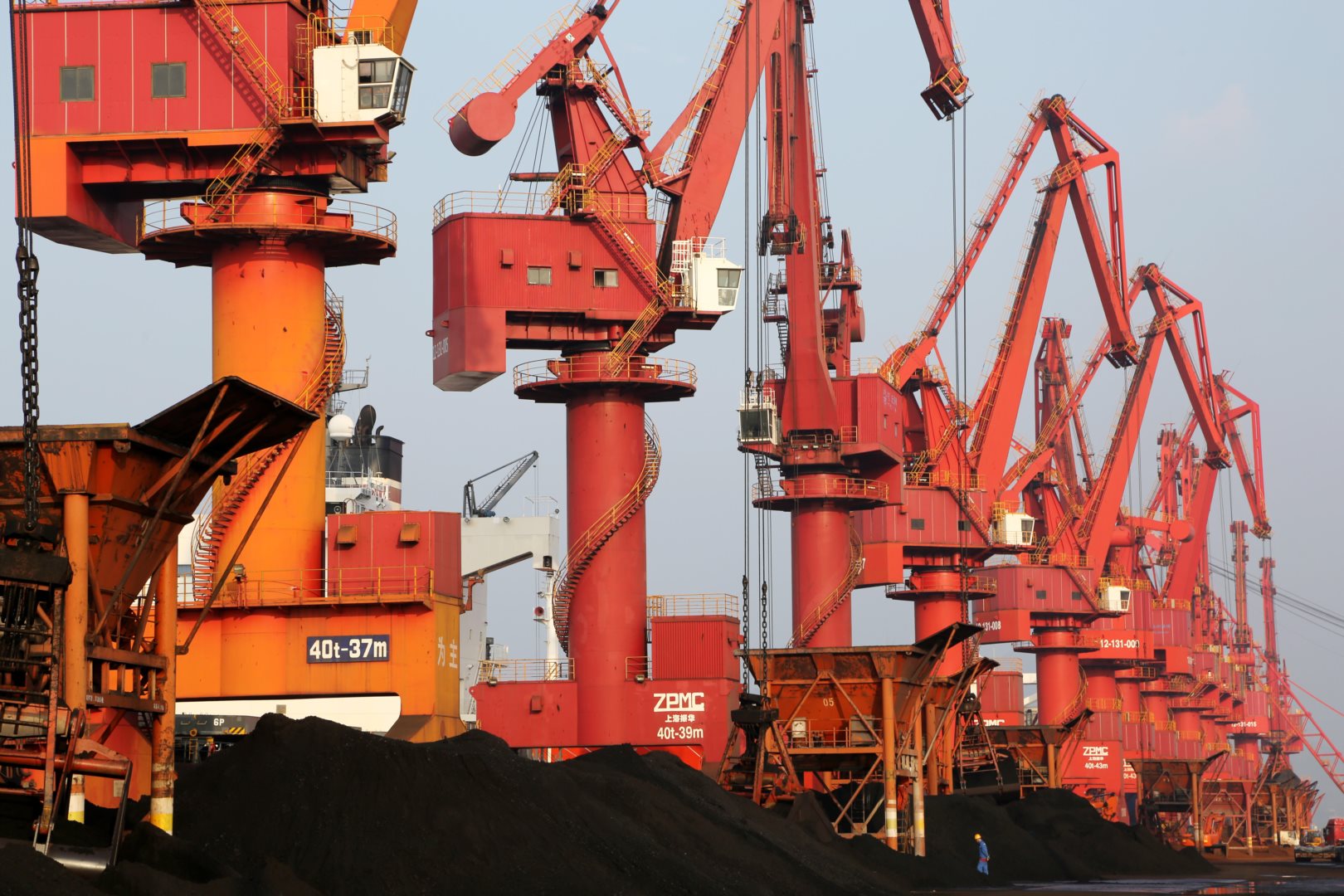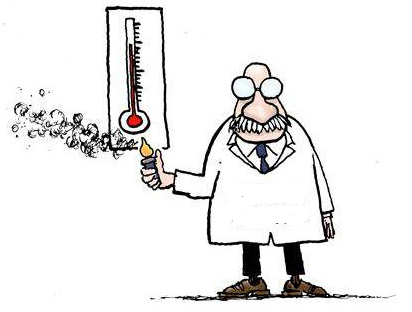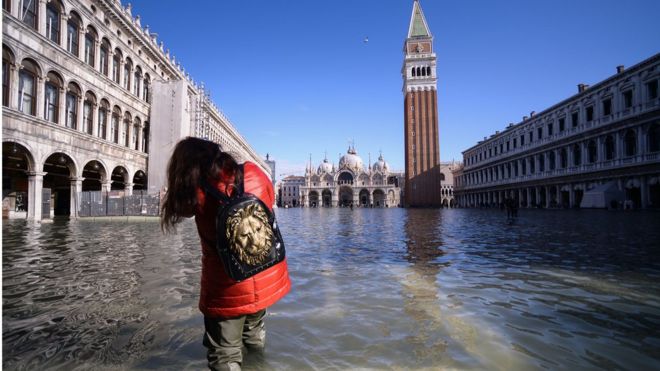Climate Science Proves Scams Don’t Die of Exposure
In this newsletter:
1) China’s New Energy Security Agenda: Coal Power To Be Top Priority
China Dialogue, 12 November 2019
2) Climate Science Proves Scams Don’t Die of Exposure
Tony Thomas, Quadrant, 14 November 2019
3) Everything You Hear About Billion-Dollar Disasters Is Wrong
Roger Pielke Jr., Forbes, 7 November 2019
4) No More Climate Excuses: Venetians Rage At Flood-Defence Delay & Politicians
The Guardian, 14 November 2019
5) Germany’s Green Suicide: Industrial Job Losses Top 80,000 With Daimler Cuts
Bloomberg, 15 November 2019
6) Prof Michael Kelly: Energy Utopias And Engineering Reality
2019 Annual GWPF Lecture (video)
7) All Hail The New CofE -- The Church of Extinction
Andy Shaw, The Spectator, 13 November 2019
Full details:
1) China’s New Energy Security Agenda: Coal Power To Be Top Priority
China Dialogue, 12 November 2019
Premier Li Keqiang has re-emphasised coal as China’s primary source of energy security, and toned down the urgency of the low-carbon transition

Cranes along a quay load ships with coal to be used for generating electricity at Lianyungang Port, China, October 2019. (Image: Alamy)
China has signalled that coal power will be a top priority within national energy policy as the government prepares its next Five Year Plan (2021-25).
On 11 October, Premier Li Keqiang chaired a meeting of the National Energy Commission in Beijing that emphasised China’s energy security and coal utilisation and downplayed the importance of a rapid transition away from fossil fuels.
Each meeting of the commission, which was established in 2010 and has met only four times, has had a significant impact on policymaking. Chaired by Premier Li and attended by more than 20 chiefs of China’s ministries and bureaus, the commission is the top body for coordinating energy policy.
Why is energy security back at the top of the agenda?
Li told the conference: “The government should diversify energy supply to improve energy security… enhance domestic oil and gas exploration and development efforts, and promote oil and gas reserves and production, in order to improve oil and gas self-sufficiency”.
The renewed focus on energy security comes amid an increase in domestic consumption of oil and gas, which is largely being met through imports. China’s dependence on energy imports rose from 9% in 2014 to more than 20% in 2018.
China’s domestic crude oil production has declined and efforts to tap unconventional sources of natural gas, such as shale gas and coalbed methane, have faltered.
Other causes for concern lie outside China. The ongoing trade dispute with the US is a threat to the energy trade between the two superpowers, and supplies from the Middle East are at risk from mounting instability in the region.
The green transition loses ‘acceleration’
The government’s concern over energy security is positive for coal given that China has lots of it. At the meeting, Li Keqiang spoke of speeding up the construction of large-scale coal transportation and electricity transmission infrastructure. He wants to promote “safe and green coal mining”, the “clean and efficient development of coal-fired power”, and to “develop and utilise coalbed methane”.
Li also downplayed China’s low-carbon energy transition. At the same meeting in 2016, Li called on China to: “increase the proportion of renewables in the energy mix” and “accelerate” such a transition. This year, there was no mention of renewable energy’s share of the energy mix and “acceleration” was replaced by the blander term “development”. The change of tone was hard to miss….
Although China is under international pressure to increase its climate ambition in 2020 and accelerate its energy transition, Chinese policymakers still see coal as the bedrock of the country’s energy security, playing a major role in the 14th Five Year Plan.
Full story
Told you so: The Road From Paris: China's Climate U-Turn

2) Climate Science Proves Scams Don’t Die of Exposure
Tony Thomas, Quadrant, 14 November 2019
It’s the tenth anniversary next week of the 2009 Climategate email dump that exposed top climate scientists’ chicanery and subversion of science – and did so in their own words and out of their own mouths, or keyboards.

I’ll list a few emails-of-infamy shortly, but first some background.
For the three years before Climategate, the climate crowd was ascendant with its pseudo-narrative of “settled science”. Al Gore’s error-riddled propaganda movie Inconvenient Truth of 2006 had swept the Western world and its readily-traduced schoolkids. In 2007 Gore and the Intergovernmental Panel on Climate Change shared the Nobel Peace Prize. In late 2008 Barack Obama won the White House, proclaiming in his modest way, “This was the moment when the rise of the oceans began to slow and our planet began to heal.”
The Climategate emails hit the blogosphere just a month before the Copenhagen summit was scheduled to lock Western countries into Kyoto Mark 2, a legally-binding commitment to renewables from 2012.
Climategate destroyed warmists’ moral high ground and reinforced the natural reluctance of most governments to up-end their economies with emission controls. The Copenhagen circus fell apart, resolving merely to “take note” of the exhortations to action by Obama and like-minded leaders.
The mainstream media strove to ignore and bury the Climategate revelations. The climate establishment ran half a dozen inquiries with limited briefs and ludicrous lack of rigour, all of which purported to clear the climate scientists of wrong-doing.[1]
But even today, ten years after, scientists faithful to their calling and disciplines can only shudder at what Climategate revealed. Those who subverted the scientific method were not fringe players but at the pinnacle. They were doing the archetypal studies “proving” catastrophic human-caused catastrophic warming (CAGW) and shaping the content and messaging in the six-yearly reports of the IPCC.
The hacked (or otherwise revealed) email archive spanning the prior decade was stored by the University of East Anglia’s Climatic Research Unit[2]. The CRU co-compiled the HadCRUT global temperature series, along with the UK Met Office’s Hadley Centre. This data set charting alleged global warming in fractions of a degree was a key input to the climate computer models forecasting doomladen heat for this century. (The model forecasts continue to exceed actual measured warming). Based on these dud modelled forecasts, the West is now spending $US1.5 trillion a year in quest of zero CO2 emissions.
Today, anyone questioning this colossal enterprise is told to “respect the science”. Based on the Climategate emails released in 2009, 2013 and 2015, I’d rather respect the Mafia, who at least don’t claim to be saving the planet. For example, today we’re told that warming of 2 deg C above pre-industrial level is some sort of a tipping point of doom. Phil Jones, Director of the Climatic Research Unit, emailed on September 6, 2007, that the supposed 2-degree limit was “plucked out of thin air”, a throwaway line in an early 1990s paper from the catastrophists at the Potsdam Climate Impacts Institute.
Now for the emails. We journos love a local angle, and here’s one – the CRU’s Ian “Harry” Harris worked for four years to de-bug and properly document a CRU data base “TS 2.1” of global stations recording monthly temperatures.
One input was from the Australian Bureau of Meteorology, with its frequent adjustments that result in a greater warming trend (think Rutherglen and Darwin). Harry’s comments in a 200-page logging of notes:
What a bloody mess. Now looking at the dates… something bad has happened, hasn’t it. COBAR AIRPORT AWS [data from an Australian weather station] cannot start in 1962, it didn’t open until 1993! … getting seriously fed up with the state of the Australian data. So many new stations have been introduced, so many false references … so many changes that aren’t documented … I am very sorry to report that the rest of the databases seem to be in nearly as poor a state as Australia was…Aarrggghhh! There truly is no end in sight…! […]
Subverting peer review
Climategate showed how warmist scientists gamed the peer review process to ensure a monopoly for their views. When two papers contrary to their ‘consensus’ were published, CRU director Phil Jones and his circle pulled out all stops to get the editor sacked and prevent such papers being considered by the IPCC.
Jones, 8 July 2004:
…I can’t see either of these papers being in the next IPCC report. Kevin [Trenberth, leading climate scientist] and I will keep them out somehow, even if we have to redefine what the peer-review literature is!
US colleague Dr Michael Mann (author of the influential-but-wrong Hockey Stick graph of the past 1000 years’ temperature), July 3, 2003:
It seems clear we have to go above [the sceptic author Chris de Freitas] … I think that the community should, as Mike H [warmist scientist] has previously suggested in this eventuality, terminate its involvement with this journal at all levels –reviewing, editing, and submitting, and leave it to wither way into oblivion and disrepute. […]
The IPCC exposed
UK Met Bureau’s Peter Thorne, concerning work on the IPCC’s 2007 fourth report:
I also think the science is being manipulated to put a political spin on it which for all our sakes might not be too clever in the long run.
Jones admits the political bias in the IPCC’s all-important Summary for Policy Makers (SPM):
He says he’ll read the IPCC Chapters! He hadn’t as he said he thought they were politically biased. I assured him they were not. The SPM [Summary for Policy Makers] may be, but not the chapters.
IPCC coordinating lead author Jonathan Overpeck:
The trick may be to decide on the main message and use that to guide what’s included and what is left out [of IPCC reports].
Need it be said that leaving out inconvenient stuff is anathema to real, genuine, principled science?
Warmist Mike Hulme agrees that
the debate around climate change is fundamentally about power and politics rather than the environment … There are not that many ‘facts’ about (the meaning of) climate change which science can unequivocally reveal
From climate scientist Giorgi Filippo, who contributed to all five IPCC Assessment Reports:
I feel rather uncomfortable about using not only unpublished but also un- reviewed material as the backbone of our conclusions (or any conclusions)…I feel that at this point there are very little rules and almost anything goes
Email 5286 from scientist Hans von Storch:
We should explain why we don’t think the information robust yet. Climate research has become a postnormal science, with the intrusion of political demands and significant influence by activists driven by ideological (well meant) concerns.”
Also from von Storch:
The concealment of dissent and uncertainty in favor of a politically good cause takes its toll on credibility, for the public is more intelligent than is usually assumed
Scientist Richard Somerville, 2004:
We don’t understand cloud feedbacks. We don’t understand air-sea interactions. We don’t understand aerosol indirect effects. The list is long.
Warmist Kevin Trenberth:
We are nowhere close to knowing where energy is going or whether clouds are changing to make the planet brighter
Michael Mann, 2006:
We certainly don’t know the GLOBAL mean temperature anomaly very well, and nobody has ever claimed we do.
Full post
3) Everything You Hear About Billion-Dollar Disasters Is Wrong
Roger Pielke Jr., Forbes, 7 November 2019
The billion-dollar disaster time series should provide us a lesson on how easy it is to promote a simple message that fits a particular narrative but which is completely misleading and even outright wrong.
The U.S. National Oceanic and Atmospheric Administration (NOAA) counts the number of disasters in the United States that result in losses of greater than $1 billion, starting in 1980. Over the past three decades that count has shown a sharp increase, from five or less such disasters each year in the decade of the 1980s to ten or more in each of the past 4 years.
That increase must be due to climate change, right? Actually, no. The billion-dollar disaster tally is easy to understand, simple to communicate, but—regrettably—incredibly misleading and just plain bad economics.
Before proceeding, it is important to underscore that climate change resulting from the emission of greenhouse gases from the burning of fossil fuels poses significant risks to our collective futures, including influences on extreme events. As a consequence, it makes sense to focus policy on the mitigation of emissions and adaptation to reduce vulnerability and exposure to weather and climate.
But the importance of climate change as a policy issue does not mean that the subject gets a free pass when it comes to scientific accuracy, and especially claims made by authoritative bodies like NOAA. To the contrary, building support for action on climate requires maintaining the highest standards of scientific integrity.
The billion-dollar disaster tally, even though it is popular, doesn’t meet that standard. The biggest problem with the time series is that it is based on a threshold of $1 billion, but both the value of the dollar changes over time (inflation) and, more importantly, the value of property and wealth subject to losses from extremes has grown dramatically over time.
When NOAA first released the billion-dollar disaster dataset in 2012, it neglected historical events that, after considering inflation, would have exceeded the billion-dollar threshold. For example, a disaster that caused $900 million in losses in 1980 (in 1980 dollars) would not have been included, although the actual loss amount would have exceeded $1 billion in contemporary times. After this was pointed out, NOAA corrected the oversight and added 19 additional events to their dataset, warning appropriately: “Caution should be used in interpreting any trends based on this graphic for a variety of reasons.”
But the inflation snafu revealed a far deeper problem with the use of the billion-dollar threshold: U.S. disaster take place at the intersection of a changing and variable climate and a nation growing in population, wealth and development. Consider that an identical hurricane making landfall in Texas in 1980 versus 2019 would result in vastly different loss totals, because today there are simply more people in more homes with more stuff than thirty years ago. In 2012, I identified nine disasters from 1980 not included in the NOAA tabulation that would likely have exceeded a billion-dollar threshold has those events occurred in 2011.
The NOAA billion-dollar disaster dataset is not a reliable indicator of trends in disasters or their costs, and it certainly is not a time series that says anything meaningful about changes in climate. Anyone wanting to look at trends in climate and weather, including extreme events, should always look first at data on climate and weather, not economic loss data.
So how might NOAA improve its economic loss record for U.S. disasters? The answer is simple: Do away with the billion-dollar threshold and look at the entire record of losses. Even better, address the effects of a growing U.S. economy, and greater loss potentials over time, by normalizing disaster loss data based on GDP (or other factors).
That is exactly what I did in the graph below, based on data from the U.S. Office of Management and Budget (GDP) and Arizona State University (hazard losses). The graph shows U.S. hazard losses from 1980 (the start of the NOAA dataset) to 2016 (the end of the ASU dataset). There is clearly no upwards trend. The apparent slight downward trend results from the “drought” of major hurricanes from 2006 to 2016, which has since ended in 2017 and 2018.
Full post
4) No More Climate Excuses: Venetians Rage At Flood-Defence Delay & Politicians
The Guardian, 14 November 2019
City’s €6bn Mose barriers to protect against high tides unfinished after 15 years

View of the flooded Piazza San Marco, 13 November 2019. Photograph by Getty.

View of the flooded Piazza San Marco, 9 December 1825. Painting by Vincenzo Chilone (1758–1839)
“We don’t know when we will reopen. Thank you, Mose!” reads the sign pinned to the door of Pasticceria Rizzardini, a small bakery and coffee shop in the San Polo area of Venice.
Established in 1742, the shop has survived many floods; a faded list of the highest records is etched by the door. But Monday night’s deluge, the worst since 1966, and the subsequent acqua alta, or high tide, on Wednesday and Thursday have severely damaged the premises. Another high tide, estimated at 1.45 metres, is forecast for Friday.
Politicians blame the floods on climate change, but Marta Garlato, whose family have owned Rizzardini since the early 1980s, and other Venetians also point to human error. Many are enraged about the authorities’ failure to complete the €6bn (£5.1bn) Mose project – a series of floodgates designed in 1984 to protect the city from high tides but still not in operation.
“There’s a lot of damage and people are feeling very angry and also very worried,” Garlato said. “Things could have been done to limit situations like this – there have been potential solutions that were never even considered. Evidently, they don’t really think of us.”
Full story
5) Germany’s Green Suicide: Industrial Job Losses Top 80,000 With Daimler Cuts
Bloomberg, 15 November 2019
Germany’s economy may have narrowly avoided a recession, but the pressure on the country’s industry shows no sign of abating.
Daimler AG said this week it will shed 10% of management positions at its Mercedes unit, lifting the tally of job cuts announced this year across Germany’s manufacturing sector to more than 80,000, according to Bloomberg calculations.
Companies from Volkswagen AG to Siemens AG are letting go workers as Germany’s powerful automotive industry is struggling with a shift toward electrification and self-driving cars, and makers of machinery and robots are hit by slower exports and trade disputes.
Full story
6) Prof Michael Kelly: Energy Utopias And Engineering Reality
2019 Annual GWPF Lecture (video)
Delivering the 2019 Annual GWPF Lecture, Prof Kelly warned that the decision to embark on a wholesale decarbonisation of the economy is beset by superficial thinking that ignores engineering reality.

Click on image above to watch full lecture
7) And Finally: All Hail The New CofE -- The Church of Extinction
Andy Shaw, The Spectator, 13 November 2019
A radical new religion is sweeping across the western world. Young people are marching from their schools and preaching on the streets.

Pensioners are blocking roads and glueing themselves to trains. ‘The End Is Nigh!’ ‘The Climate is Collapsing!’ is their new call to prayer.
Extinction Religion is building its church inside our primary schools, colleges and town centres. It is gathering a flock of anxious and fearful people and inspiring them to protest and get arrested. But, as the Church of Extinction (CofE) replaces the old CofE, what is at the core of their faith?
God
In the new CofE, the Earth, itself, is God. The primordial deity is reified as the giver of life and the essence of purity, unsullied by human activity. Known to some worshippers as Gaia, the biosphere is believed to inhabit a spirit that wishes to return to a state of natural equilibrium. CofE! literature doesn’t clarify whether this ideal state is to be found in a previous ice age, prior to the evolution of fish or sometime around 1780. However, CofE! devotees can hear the groans of their god, suffering from the sins of humankind.
The Devil
Carbon dioxide, the colourless odourless gas, is the evil spirit. CofE! mythology portrays carbon dioxide as the silent poisoner of the virginal Green Gaia. Although, CO2 is essential to the healthy growth of plants and trees, which makes the earth so green, it is castigated as an evil gas. Why would they demonise something which is essential to life itself? The answer lies in human sin. When we heat our homes, cook, travel and produce goods, CO2 is a natural by-product. It is the vaporous proxy for our indulgence in the simple pleasures of modern convenience. The fumes of human sin.
The Priesthood
The Church of Extinction has a Priesthood. It interprets the silent words of Gaia. They have named it ‘The Science’, to make it sacred in our atheist world. Specially trained scholars decipher the alignment of numbers, which cluster within the ‘climate models’ of large computers. The secular theologians are known as ‘climate scientists’. They prepare special formulations of ‘assumptions’ and ‘data normalising techniques’ which feed ‘The Science’. Encyclicals, known as ‘press releases’ are delivered daily in the readings of ‘the news’. Although the Priesthood are unable to provide weather forecasts beyond the next fortnight, they predict temperatures in 100 years-time and apocalypse in decades. The Priests of CoE! are rewarded for their work with bursaries, grants and speaking engagements at the pulpits around the world.
Saintliness
The child saint, Greta Thunberg, was the first human to be canonised by the CofE. She has been recognised for her transcendental gift – the unique ability to see the colourless carbon dioxide poisoning our atmosphere. She refuses to perform miracles – she has failed to revive dying polar bears or stop ice melting – but she is recognised by the great and good as a prophet. Unlike previous saints, Greta knows that her God is an angry God and she implores the children of CofE! to chant “How Dare You!” and “You have stolen my future!”
Heretics
The CofE has been successful in attracting members of the establishment to its cause. Although not everyone believes that the climate is changing at an alarming rate, or that CO2 is the primary cause, or that we can reduce CO2 output without destroying human welfare, or that earthly extinction is remotely likely, they have declared that there is a consensus of opinion. Those that question any elements of ‘The Science’ are known as ‘climate deniers’. They are heretics who are infected with the evil spirit and cast out of public life.
Full post
The London-based Global Warming Policy Forum is a world leading think tank on global warming policy issues. The GWPF newsletter is prepared by Director Dr Benny Peiser - for more information, please visit the website at www.thegwpf.com.



No comments:
Post a Comment
Thank you for joining the discussion. Breaking Views welcomes respectful contributions that enrich the debate. Please ensure your comments are not defamatory, derogatory or disruptive. We appreciate your cooperation.